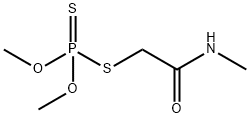?????? C??? ??, ??, ??
??
Dimethoate
is colorless crystalline substance, mp 49 ?C, bp
117 ?C/0.1 mm Hg, vp 0.25 mPa (25 ?C). The solubility in
water is 23.8 g/L at 20 ?C and pH 7. It is readily soluble
in polar organic solvents. Log Kow = 0.7. Dimethoate
is relatively stable in aqueous media at pH 2–7 and
hydrolyzed in alkaline media; DT
50 (20 ?C) at pH 9 is 12 d.
??? ??
Dimethoate is a gray-white crystalline solid at room temperature. It is sparingly soluble in
water, soluble in methanol and cyclohexane, but very soluble in chloroform, benzene. It has
been classifi ed by the US EPA under GUP. Dimethoate is used extensively for the control
of crop pests, such as mites, aphids, thrips, plant-hoppers, white-fl ies, and a wide range
of other insects that damage, crops, fruits, vegetables, and ornamental plants. Dimethoate
is also used for the control of cattle grubs that infect livestock. Thermal decomposition of
dimethoate is highly hazardous owing to the release of fumes of dimethylsulfi de, methyl
mercaptane, carbon monoxide, carbon dioxide, phosphorus pentoxide, and nitrogenoxides.
??
Dimethoate is used to control of a wide range of insect and mite
pests in many crops. It is also used to control flies in animal houses.
??
ChEBI: A monocarboxylic acid amide that is N-methylacetamide in which one of the hydrogens of the methyl group attached to the carbonyl moiety is replaced by a (dimethoxyphosphorothioyl)sulfanediyl group.
?? ??
A white crystalline solid, with a camphor-like odor, white to grayish crystals for technical product. Dimethoate is a contact and systemic organophosphate insecticide effective against a broad range of insects and mites when applied on a wide range of crops. Dimethoate has not been produced in the U.S. since 1982.
??? ?? ??
Dimethoate is stable in aqueous solution but is hydrolyzed by aqueous alkali.
?? ???
Dimethoate is incompatible with alkaline preparations. Dimethoate is slightly corrosive to iron. Dimethoate is incompatible with sulfur based formulations. . Organophosphates are susceptible to formation of highly toxic and flammable phosphine gas in the presence of strong reducing agents such as hydrides. Partial oxidation by oxidizing agents may result in the release of toxic phosphorus oxides.
????
Very toxic; the probable oral lethal dose in humans is between 50-500 mg/kg, or between 1 teaspoon and 1 ounce for a 70 kg (150 lb.) person. Dimethoate is a cholinesterase inhibitor, meaning it affects the central nervous system. Death is due to respiratory arrest arising from failure of respiratory center, paralysis of respiratory muscles, intense bronchoconstriction or all three.
????
As with other organophosphorus pesticides, container may explode in heat of fire. The temperature of storage should not exceed 70-80F. Keep away from sources of heat, flames, or spark-generating equipment. Unstable in alkaline solution. Hydrolyzed by aqueous alkali. Stable in aqueous solutions. The compound is stable for 2 years under environmental conditions if stored in undamaged, original containers.
???
Insecticide, Miticide: Dimethoate is used to kill mites and insects systemically and on contact. It is used against a wide range of
insects, including aphids, thrips, planthoppers, and whiteflies on ornamental plants, alfalfa, apples, corn, cotton,
grapefruit, grapes, lemons, melons, oranges, pears, pecans, safflower, sorghum, soybeans, tangerines, tobacco,
tomatoes, watermelons, wheat, and other vegetables. It is
also used as a residual wall spray in farm buildings for
house flies. Dimethoate has been administered to livestock
for control of botflies. Dimethoate is available in aerosol
spray, dust, emulsifiable concentrate, and ULV concentrate
formulations.
???
REBELATE®; CEKUTHOATE®;
CHIMIGOR 40®; CYGON 400®[C]; DEFEND®;
DAPHENE®; DANADIM®; DANADIM® PROGRESS;
DE-FEND®; DEMOS NF®; DEVIGON®; DICAP®;
DIMATE 267®; DIMET®; DIMETHOATE 40;
DIMETHOPGAN®; FERKETHION®; FOSTION
MM®; KENLOGO®; NUGOR®; PERFEKTION®;
ROGODAN®; ROGODIAL®; ROGOR®; ROXION®;
SEVIGOR®
?? ?? ??
This organophosphorus compound is used as a contact
and systemic insecticide and acaricide. It induced an
erythema-multiform-like contact dermatitis in a ware-
houseman in an agricultural consortium.
Safety Profile
A deadly human
poison. Poison by ingestion, skin contact,
intraperitoneal, and subcutaneous routes.
Moderately toxic by intravenous route.
Human systemic effects: coma, dyspnea,fasciculations. Questionable carcinogen with
experimental carcinogenic data.
Experimental teratogenic and reproductive
effects. Human mutation data reported.
When heated to decomposition it emits very
toxic fumes of NOx、, POx, and SOx. See also
ESTERS.
Carcinogenicity
Rats given diets with 0, 5, 25,
or 100 ppm dimethoate (0, 0.25, 1.25, or 5 mg/kg/day) for
2 years showed dose-related trends for spleen hemangiosarcoma;
combined spleen hemangioma and hemangiosarcoma;
and combined spleen hemangioma, hemangiosarcoma, and
skin hemangiosarcoma . There were also significant
differences in pair-wise comparisons between controls and
low-dose (0.25 mg/kg) or high-dose (5 mg/kg) groups for
spleen (hemangioma/hemangiosarcoma) and combined
tumors of spleen and skin hemangiosarcoma and lymph
angioma/angiosarcoma; and between low and high doses
for all tumors combined.
?? ?? ??
Dimethoate is a systemic insecticide which is rapidly translocated to all
parts of the plant. Metabolism to omethoate (dimethoate oxon), the active
cholinesterase inhibitor, is a major pathway in both animals and plants.
Degradative metabolism is either via dealkylation to yield both des-O-
methyldimethoate and des-O-methylomethoate, followed by hydrolysis
or dealkylation to give mono- and di-methyl phosphate, phosphorothioate
and phosphorodithioate esters which are ultimately degraded to phosphate.
An additional mechanism is through hydrolysis of the amide
group to give dimethoate and omethoate carboxylic acids. An important
additional metabolic pathway is oxidative N-demethylation of dimethoate
and omethoate to give des-N-methyldimethoate and des-N-methy
lomethoate via their respective N-hydroxymethyl derivatives. It is possible that the N-demethylation route could precede amidase action
leading to dimethoate and omethoate carboxylic acids which are excreted
in mammals. The 'thioglycolate' part of the molecule is metabolised to
α-hydroxy-N-methylacetamide in mammals.
?????? ?? ?? ? ???
???
?? ??







